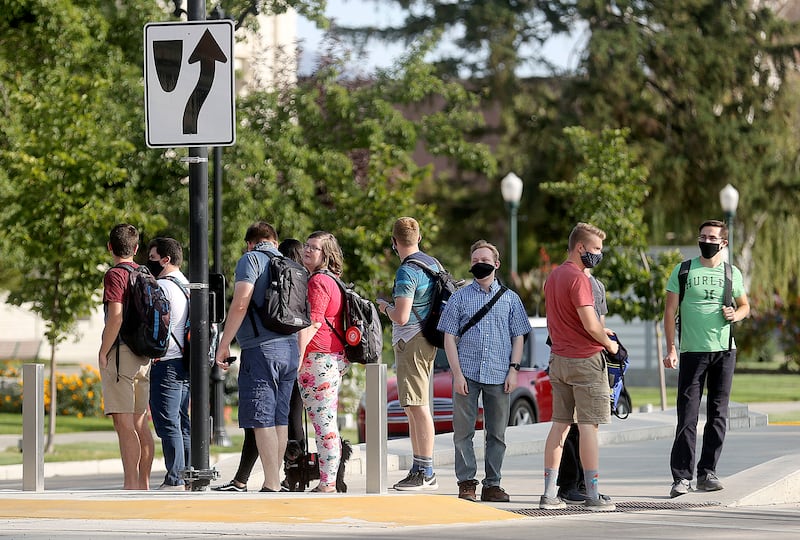I was slouched in a chair late yesterday afternoon, watching my BYU professor flip through PowerPoint slides on Zoom, when a text came in. I picked up my phone and saw it was from my roommate.
“Hey Sam,” he said. “You might not wanna come back to the apartment for a while.”
He just found out that his girlfriend — who he had visited for the better part of last weekend — had tested positive for COVID-19. I had received word earlier in the day that another roommate’s girlfriend was showing symptoms — “probably a cold,” they assumed, but better safe than sorry. My third roommate, the unexposed one, and I had already packed up bags and loaded a car. As soon as our Zoom classes ended, we hit the road.
We’re now midway into our fourth week of fall semester 2020 at BYU, and I’m back where I started a month ago: sequestered in my mom’s basement in Salt Lake City. This time, though, I have a roommate, and the moments that were previously filled with enjoying the last seconds of summer are now populated with homework, online classes and tests. We are anxiously awaiting the results of the COVID-19 tests we took this morning, too, which add a heightened level of worry — no, uneasiness — to the whole operation.
BYU and its sister to the west, Utah Valley University, have been in the spotlight in recent days for all the wrong reasons. Since students flooded Utah County in late August, COVID-19 cases have skyrocketed. BYU’s online case tracker shows over 1,100 reported cases, some 700 of which have since recovered and are out of quarantine. Another 400 are still sick. My roommate and I might join those ranks soon.
At a casual glance, those numbers seem miniscule. Less than 1% of the campus community is currently sick. But it feels like much, much more. Our neighboring apartment just recovered from an all-encompassing bout with the sickness. So did the apartment two doors down. My lone in-person class — a socially distanced, masked one — has slowly been shrinking in size. Now, some 20 students tune in through Zoom every class session. Each of those digital faces on the screen have contracted or been exposed to COVID-19. “It’s everywhere, man,” my healthy (for now) roommate said, somewhat in disbelief, as we trudged up I-15 Wednesday night.
BYU and UVU gave its students a two-week notice, of sorts, on Tuesday. “If circumstances do not improve within the next two weeks,” the campus-wide email warned, “more dramatic action will be necessary,” like a multi-week, mandatory quarantine, or a shift to online classes. The email also explicitly told students to limit social interactions to their own households — to our roommates — and to avoid gatherings of any size where social distancing and mask-wearing are not practiced.
I’d guess that much of the spread in Provo and Orem right now is coming from small gatherings. Sure, a handful of students are attending big parties and gatherings. I assume most are smarter than that. Far more prevalent, though, are the maskless movie nights and family home evenings and dates. All it takes is one person for COVID-19 to spread. And, in many cases, you don’t even have to be the one who first gets exposed directly. My apartment is learning that the hard way.
In terms of on-campus protocol, BYU seemed to do all the right things. Masks are enforced, social distancing is practiced and I genuinely feel safe going to class. Once you step off campus, though, it’s laissez-faire. Students go to college to, well, go to college — and this year’s crash course in redefining the college experience may show that there is really no way to safely attend college during a pandemic.
That should have been expected. That doesn’t excuse negligent behavior, though. The idea that young people are completely immune to the virus — and that getting sick only affects the individual — is spreading faster than the virus itself.
“The idea that young people are completely immune to the virus — and that getting sick only affects the individual — is spreading faster than the virus itself.” — Samuel Benson
Consider this comment, sent by a friend in a group chat earlier this week: “Instead of asking us to be extra careful, President Kevin Worthen should mandate a university-wide rave where we all get infected and get the virus. That way after a couple weeks of online sick school, we can come back and be free to chill with each other.”
A month ago, I would have thought he was joking. Actions speak louder than words, though, and the past month in Provo shows that some really buy into that.
My roommate and I have no idea when we’ll be back in Provo. Everything hinges on the results of our tests and that of our roommates. For now, we’re hunkering down and gratefully retrieving toast and eggs at the top of the stairs.
Of course, there’s the chance that we will head back to Provo right in time for a campus-wide quarantine or a shift to online classes. The only thing stopping that is a massive shift in behavior, preceded by a shift in attitude, in the next two weeks. It’s not just the big parties that are spreading this virus, but the small ones.
I’m hopeful we can see a massive shift in attitude, allowing us to stay on campus. Betting on that, though, is unwise. For now, my roommate is spot on: COVID-19 is everywhere, man.


